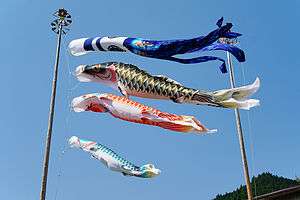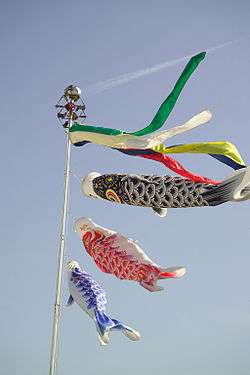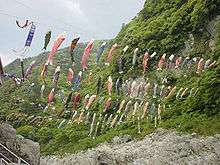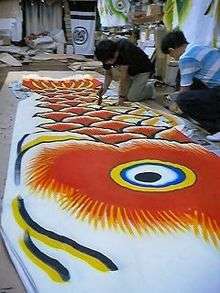Koinobori
Koinobori (鯉のぼり), meaning "carp streamer" in Japanese, are carp-shaped windsocks traditionally flown in Japan to celebrate Tango no sekku (端午の節句), a traditional calendrical event which is now designated a national holiday: Children's Day (Kodomo no Hi, 子供の日).[1] These windsocks are made by drawing carp patterns on paper, cloth or other nonwoven fabric. They are then allowed to flutter in the wind. They are also known as satsuki-nobori (皐のぼり).




Children's Day takes place on May 5, the last day of Golden Week, the largest break for workers and also a week in which businesses usually close for up to 9–10 days. Landscapes across Japan are decorated with koinobori from April to early May, in honor of children for a good future and in the hope that they will grow up healthy and strong.
Description
A typical koinobori set consists of, from the top of the pole down, a pair of arrow-spoked wheels (矢車, yaguruma) with a ball-shaped spinning vane, flying-dragon streamer (飛龍吹流し, hiryū fukinagashi) that looks like a windsock. The number and meaning of the carp socks or koinobori that fly beneath the streamer has changed over time. Traditionally, the set would contain a black koinobori representing the father, followed by a smaller, red koinobori representing his eldest son. This is why, according to the Japanese American National Museum, in the traditional "children's song," the red one (higoi) represents the eldest son. If more boys were in the household, an additional blue, green and then, depending on the region, either purple or orange koinobori were added. After the government's decree that converted Boy's Day (Tango no Sekku) into the present Children's Day (Kodomo no Hi), the holiday came to celebrate the happiness of both boys and girls. As a result, the red koinobori came to represent the mother of the family and it is not uncommon for the color to be varied as pink. Similarly, the other colors and sizes of carp came to represent all the family's children, both sons and daughters. At present, the koinobori are commonly flown above the roofs of houses with children, with the biggest (black) koinobori for the father, next biggest (red or pink) for the mother, and an additional, smaller carp of a different color for each child in decreasing order by age.
These koinobori range from a few centimetres to a few metres long. In 1988, a 100m long koinobori weighing 350kg was made in Kazo, Saitama.
History
According to the Japanese American National Museum, the koi fish was chosen as a symbol for Boys' Day because "the Japanese consider it the most spirited fish -- so full of energy and power that it can fight its way up swift-running streams and cascades. Because of its strength and determination to overcome all obstacles, it stands for courage and the ability to attain high goals. Since these are traits desired in boys, families traditionally flew Koinobori from their homes to honor their sons." The streamers also pay homage to a myth from the late Han Dynasty about a golden koi fish that swam up a waterfall at the end of the Yellow River and became a dragon.[2]
In addition, there are many different theories about the origins of Children's Day itself. One source states that "Boy's Day, now Children's Day, has been celebrated for more than 700 years, but no one knows exactly when or why it began. Another source says that it started in the year 1282, as a celebration for a victory won by samurai warriors in a battle with invaders".citation needed Asia Kids Society has another theory that "Until 1948, May 5 was called Tango no Sekku and only honored boys. A separate holiday called Hinamatsuri or "Dolls' Day" celebrated girls on March 3. Even now, on this day girls still receive dolls that had been passed down to their grandmothers and mothers". This fact led to a combination of holidays, and as described by AKS, "For many families, May 5 still centers on boys. Some people say that Hinamatsuri for girls should become an equal holiday instead of combining them into one". Whilst both sources have different theories, no one truly knows when the holiday actually began.
Today, along with the raising of Koinobori in each household, Asia Kid Society states that children also "indulge in kashiwa mochi", sticky rice cakes wrapped in oak leaves, and other sweets. As a tradition, throughout Children's Day, children also thank and show respect for relatives, parents, and teachers for support throughout their life.
Koinobori song
A famous Koinobori song often sung by children and their families. It was published in Ehon shōka haru no maki (Picture Songbook, Spring) in 1932. The lyrics are by Miyako Kondō (近藤宮子), the composer is unknown.
| Standard Japanese | Hiragana | Rōmaji | Translation |
|---|---|---|---|
|
屋根より 高い 鯉のぼり |
やねより たかい こいのぼり |
yane yori takai koinobori |
Higher than the roof-tops are the koinobori |
See also
References
- "Trend Illustrated Japanese-English Dictionary of Things Japanese", Shogakukan, 1999
- https://koistory.com/blog/koi-fish-meaning-and-myth
External links
